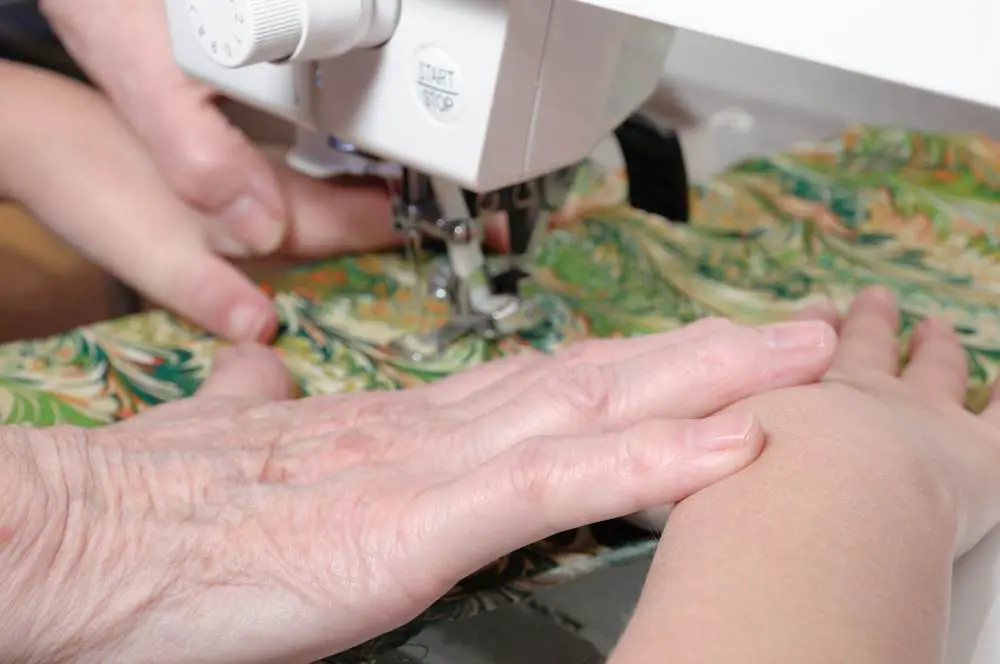
Sewing is a useful and rewarding hobby that allows you to create and mend clothing, craft projects, home decor items, and much more. However, learning to sew can seem daunting, especially for total beginners. In this complete guide, we will discuss whether sewing is hard to learn or not.
Table of Contents
The Short Answer
The short answer is that sewing is not inherently difficult to learn, but it does require patience, practice, and an understanding of some basic techniques. With the right guidance and commitment, sewing is a learnable skill for beginners of all ages and backgrounds. Some key factors that influence how quickly you can pick up sewing include:
- Dedicated practice time – Consistent practice is key to building muscle memory and developing your skills. The more time you can devote to regular sewing practice, the faster you will progress.
- Quality instruction – Taking lessons from an experienced sewing teacher, either privately or through a class, can help you avoid developing bad habits and accelerate the learning process.
- Managing frustration – Sewing involves coordination and problem-solving skills that may require repetitive practice and troubleshooting. Having patience with yourself and not getting discouraged by mistakes will make learning easier.
- Natural ability – While not strictly necessary, some individuals may have an innate aptitude for sewing skills like spatial visualization, dexterity, and attention to detail. But sewing is learnable for anyone with dedication.
Overall, sewing is within reach of any motivated beginner. While fast mastery is unlikely, you can become a competent sewist by sticking with it through both achievements and frustrations. Consistent practice and quality instruction will get you there.
Basic Skills to Learn
Sewing requires a combination of technical know-how, soft skills, and machine operation. Here are some of the fundamental skills that new sewists need to focus on:
Technical Skills
- Fabric selection and preparation – Choosing the appropriate fabric type and weight for your project and pre-treating it properly.
- Taking measurements – Accurately measuring yourself or what you are sewing to get a precise fit.
- Pattern reading – Understanding commercial pattern guides, markings, and instructions.
- Cutting fabric – Using the pattern pieces to cut your fabric cleanly and precisely.
- Pinning and marking – Marking fabric pieces before sewing for things like darts, pleats, and placement.
- Seam allowances – Sewing seams with the correct seam allowance for the project type and fabric.
- Pressing – Pressing seam allowances, darts, and hems rather than only ironing.
Soft Skills
- Planning – Planning the steps of your project in advance for organization.
- Troubleshooting – Identifying problems in a project and brainstorming solutions.
- Spatial visualization – Envisioning how 2D pattern pieces become a 3D garment.
- Manual dexterity – Using your hands and fingers fluidly and precisely.
- Attention to detail – Catching small inconsistencies in stitching, fit, etc.
Machine Skills
- Threading the machine – Threading the top and bottom for sewing.
- Winding a bobbin – Winding thread neatly and evenly onto a bobbin.
- Adjusting settings – Changing the stitch length, tension, pressure and other variables.
- Machine maintenance – Cleaning lint and oiling the machine when needed.
- Basic stitches – Doing a straight stitch, zigzag, and other stitches.
- Securing threads – Locking stitching with backstitching or knotting threads.
Mastering these fundamental skills takes practice but will give you a solid foundation for sewing successfully as a beginner.
How Long Does it Take to Learn to Sew?

How quickly you are able to pick up sewing depends heavily on the time and effort you put in. With regular practice, most beginners can get comfortable with basic sewing techniques within 2-3 months. However, spending years mastering advanced skills is also common.
Here is a rough timeline of sewing milestones you can expect as a newer sewist:
First Month
- Identify and familiarize yourself with your sewing machine parts and accessories.
- Practice basic machine operation: threading, winding a bobbin, adjusting settings.
- Learn basic hand-sewing techniques like basting, backstitching, knotting threads.
- Sew very simple projects like tote bags, pillowcases or blankets to practice straight lines.
Second Month
- Feel comfortable using your sewing machine, including changing stitches and tension.
- Make simple clothes like elastic-waist skirts, simple tops, or pajama pants with mostly straight seams.
- Learn skills like pinning, cutting, ironing, and seam finishes.
- Read and follow commercial sewing patterns for simple designs.
Third Month
- Craft more complex garments using curved seams, zippers, buttons, and lining.
- Start experimenting with intermediate skills like darts, gathering, and hemming.
- Troubleshoot problems like skipped stitches, uneven tension, or seam puckering.
- Build experience reading and manipulating sewing patterns.
- Increase precision with cutting, seam allowances, pressing, and details.
With dedicated practice, most beginners reach a point of feeling capable sewing simpler projects within a few months. But acquiring more advanced skills like tailoring, couture techniques, and pattern drafting may take many years. Be patient, embrace the learning process, and you will be sewing independently in no time.
Tips for Learning to Sew Faster
Follow this advice to accelerate your learning as a beginner sewist:
Start with a sewing class or private lessons – Learning from an experienced teacher allows you to ask questions and get feedback, avoiding self-taught bad habits.
Invest in a quality sewing machine – Choose a sturdy machine with options for easy threading, bobbin-winding, and adjustable stitches.
Stick to wovens early on – Woven fabrics are more forgiving to learn on than slippery or stretchy knits and satins.
Match fabric weight to skills – Avoid heavy canvas, silk, vinyl, or leather until you have experience on lighter cottons and quilting fabrics.
Focus on straight lines first – Master straight seam construction before attempting curves, corners, and tricky seams.
Read your machine’s manual – Consult the manual to utilize all your machine’s features properly from the start.
Start small – Mini-projects let you practice fundamental techniques without getting overwhelmed.
Use sewing pattern guides – Follow pattern instructions precisely when starting out for process familiarity.
Watch online video tutorials – Supplement in-person lessons with carefully selected online learning resources.
Be consistent – Try to sew a little bit every day rather than tackling big projects inconsistently.
Stick with it through frustrations – Persist even when projects don’t go smoothly and you need to unpick seams and re-sew.
Ask for help – Don’t struggle alone; consult your teacher, the pattern’s help lines, or online sewing communities.
Review lessons often – Revisit beginner techniques frequently so they become ingrained muscle memory.
With regular, mindful practice and quality instruction, sewing mastery will come easier than you think! Believe in yourself and stick with it past the beginner phase.
Common Beginner Sewing Challenges
Sewing comes with a learning curve, and developing new manual and problem-solving skills takes time. As a beginner, you will likely face some of these common challenges at first:
Technical Challenges
- Skipped stitches – Usually from incorrect thread tension or fabric moving around.
- Uneven seam allowances – Stay focused and use a seam guide for consistency.
- Fabric shifting – Use more pins, clips, weights, or spray adhesive to prevent slipping.
- Inaccurate cutting – Carefully measure, pin, and use sharper shears.
- Puckered seams – Adjust tension, stitch length, or hand-baste first.
- Raw edges – Improve seam finishes like pinking, serging, zig-zag, or overcasting.
Execution Challenges
- Crooked lines – Go slowly and use seam guides and tape markers to maintain straight lines.
- Mismatched seams – Pin patterns together and mark matching points with notches before cutting.
- Inaccurate darts – Mark the dart legs clearly and stitch from wide to narrow precisely.
- Inconsistent corners – Clip inner curves and points; approach outer curves slowly.
- Messy finishes – Take time to press well, trim and notch seams, and hand-sew closures neatly.
Fitting Challenges
- Ill-fitting garments – Make sure to pre-wash fabric, allow room for wearing ease, and do a test garment.
- Gaping, rippling areas – May need darts or seams adjusted or graded seam allowances.
- Twisted garments – Mark grainlines and ensure pattern pieces aren’t shifted off grain.
Don’t get frustrated! These issues are common when starting out and get better with practice. Seek help from teachers, advice blogs, or forums if you get stuck.
Tips for Avoiding Beginner Mistakes
Here are some tips for avoiding the most common beginner sewing mistakes:
- Read instructions fully before starting sewing to avoid missing key steps.
- Make sure your machine is threaded properly or else stitches may skip and snag.
- Do test seams on scraps first when sewing a new fabric or tricky technique.
- Always do a test garment and fit adjustments before cutting into nice fabric.
- Secure your stitches by backstitching so seams don’t unravel.
- Check tension settings based on your thread and fabric thickness.
- Use new machine needles so stitches form cleanly without skipped stitches or snags.
- Pin often to keep fabrics together and prevent shifting while sewing.
- Go slowly around curves, corners, and thick seams to maintain control.
- Press as you sew so pieces lay flat and seams are easier to manipulate.
- Measure accurately for cut pieces, seam allowances, hem depths, and more.
- Stay focused on straight seam alignment and other precision techniques.
Avoiding easily preventable mistakes will help you build good habits and skills faster. But also remember perfection comes with time, so be patient and persistent.
Frequently Asked Questions
Is it hard to learn to sew?
Sewing is not inherently hard to learn, but it does present challenges. Developing the technical skills and spatial abilities for accurate sewing takes regular practice. Patience is required when progress seems slow. However, sewing is very attainable for beginners who are willing to make steady efforts. Taking classes and getting help when needed makes the learning process easier.
How long does it take to get good at sewing?
Most beginners can become competent at basic sewing techniques within 2-3 months of regular practice. But developing truly advanced skills like tailored garment construction, couture sewing, pattern drafting, and more can take many years of dedicated work for hobby sewists. Focus on incremental improvement, not fast mastery.
What are the easiest sewing projects for beginners?
Some good beginner sewing projects include: simple pillowcases or totes to practice straight seams, pajama pants or other garments with elastic waists, aprons, blankets, zipper pouches, or other small accessories. Choose woven fabrics, simple designs, and commercial patterns made for beginners when starting out.
Should I start sewing by hand or machine?
Learning basic hand-sewing techniques first can benefit new sewists by building fine motor skills without the added complexity of machines. But for efficiency, purchasing a starter sewing machine for beginners fairly early on is recommended. Take time to learn your machine’s functions properly.
What sewing machines are best for beginners?
Look for an entry-level mechanical sewing machine that offers essential straight stitch and zigzag options, adjustable stitch length and width, easy threading and bobbin winding, speed control, and multiple presser feet. User-friendly machines from brands like Singer, Brother, Janome, and Juki are good for beginners.
Conclusion
Learning to sew requires dedication through challenging moments, but the sense of satisfaction from creating handmade items makes it rewarding. While fast mastery is unrealistic, beginners should see steady sewing improvement within a few months by sticking to basic projects and practicing fundamental techniques regularly. Invest in quality instruction, be patient with yourself, and don’t get discouraged. With the right guidance and persistence, sewing skills can become second nature. The possibilities are endless once you have developed a strong foundation. Happy sewing!
Yorum
Tuesday 8th of August 2023
Thnnnxxx.
Pvc kapı ve pencere
Tuesday 1st of August 2023
Bu güzel bilgilendirmeler için teşekkür ederim.